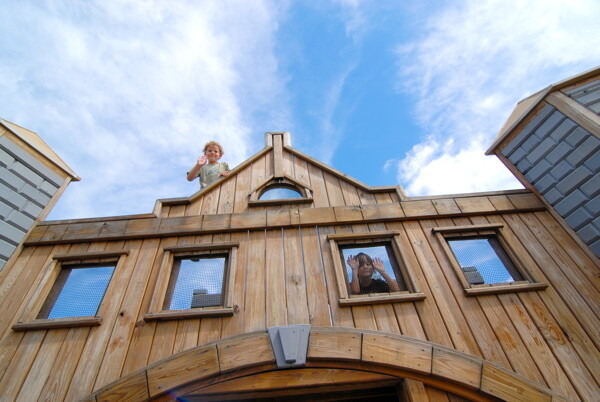The Castle Playground
how a neighborhood made something massive happen
Trevor Kupfer, photos by Leah Dunbar |

We’re in a time where a group of people can present and justify a case for something new before the city, but, just as quickly, get turned down because of budget strains. It’s easy to get jaded, thinking the community is too conservative to ever make something new happen. But we’re also in an area where, a mere three years ago, a small group of parents managed to gather almost 1,000 community members and raise more than $150,000 to build a playground.
Beside the fact that Menomonie’s River Heights Elementary playground is the most unique and arguably “the best” in the Valley, it’s also an example of community building and grassroots movements at their very best.
The idea was initially conceived by Bryan Beamer, one of the parents in the area that noticed the splintering condition of the playground and suggested pooling together the neighborhood resources for a new one. “I’m credited with coming up with the idea … but by the time it really got going, I was just a cog in the wheel,” he said.
What started as a dozen parents and PTO members soon grew to include partnerships with the school’s principal and staff, an architectural design class at Stout, dozens of businesses, and even the kid themselves, all of which volunteered as much as 15 hours a day and thousands of dollars to become a reality.
“It was wonderfully surprising, but frankly when I think back I shouldn’t have been so shocked,” PTO member Kate Jarvi said. “When we had that garage sale to start fundraising, we were inundated with stuff. It wasn’t a huge financial success, but that showed just how many people wanted to help this happen.”
 Another major catalyst was Leathers Associates, a New York firm they contracted with that has helped nearly 2,000 other communities do the same thing. They went to the school, asked every classroom what they wanted, then did the same with parents and even local historian John Russell.
Another major catalyst was Leathers Associates, a New York firm they contracted with that has helped nearly 2,000 other communities do the same thing. They went to the school, asked every classroom what they wanted, then did the same with parents and even local historian John Russell.
“The community aspect is almost more important than the playground itself,” John Dean told the Dunn County News during the development. “It’s an experience that a town will never forget.”
On top of swings, monkey bars, bridges, and slides, the end result incorporates a castle entrance resembling the Mabel Tainter, a playhouse fashioned after Caddie Woodlawn’s home, a cheese sandbox, Viking ship, climbing wall, painted murals, interactive chimes, and secret message pipes.
A playground of this kind would normally cost about $300,000, but donated labor and materials cut it almost in half. And it helps to get grants from Menomonie Community Help Foundation, Presto, LE Phillips Foundation, Bremer Banks, and Thrivent Financial to the tune of about $100,000. If you visit the playground, where the rest of the money came from is apparent, as individual boards, brick pavers, and even whole features have names on them. Events like pancake breakfasts and penny drives helped, too.
The building itself took five very carefully planned out days. “There were alums, parents, grandparents, Stout students, artists, and community members just plain doing it out of the goodness of their hearts,” Jarvi said. “When it was over, it was so much work that it was almost hard to look at. But since then it gives everyone involved a sense of joy. Not so much accomplishment as joy, because there are so many children who now refer to it as their playground. It’s theirs. That sense of ownership is just so cool.”
We talked to others that helped build it, and all of them felt the same way. “Maybe you can take $150,000 and give it to the city to build something like this,” Beamer said, “but getting everybody involved makes it something bigger.”
Paul Mommsen, a parent and the materials coordinator, finished Brian’s sentiment. “I’ll still go through the grocery store and spot someone we worked with, and it sparks up a conversation. Maybe about our schools or just the community in general. It makes me wish there were more things like this going on.”


















